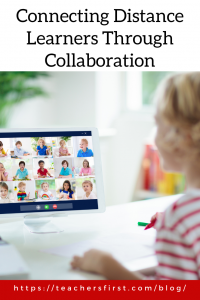Teaching and learning are complex, and remote learning provides another layer of challenge. Many teachers across the country have recently faced the task of delivering dynamic, collaborative remote learning activities that encourage students to get involved with the content and their classmates. The physical separation of the students in remote learning experiences limits the ability to assign traditional collaborative activities often found in face-to-face classrooms. But collaboration is a critical 21st Century Skill regardless of the delivery method or learning environment, and it’s an essential part of how we need to operate to be successful in today’s world.
Isolation and disconnection are magnified when remote learning experiences only allow students to share information through individual activities. The remote learning environment design must focus on connecting learners through ideas and creation. Collaboration plays a crucial role in connecting learners and engaging students during remote learning. Listed below are activities and resources to cultivate collaboration during remote learning.
Breakout Rooms
Google Meet, Microsoft Teams, and Zoom offer teachers and students the affordance of connecting remotely through synchronous instruction. Each platform has a breakout room feature that allows you to engage students in participatory and collaborative activities in small groups. Students can peer review work, brainstorm ideas, reflect on takeaways from the learning experience, solve problems together, or participate in active discussions throughout their time together online. Use Jamboard (reviewed here), a collaborative online whiteboard, to cultivate collaboration during remote learning. Breakout rooms promote small-group discussions, which make a large class feel more manageable. Students can ask for help and connect with their classmates.
Jigsaw Technique
The jigsaw technique is a cooperative learning strategy for remote learning where the activity has smaller pieces or assignments for a group. Each student’s part of the activity is essential for completing and providing a complete understanding of the lesson’s purpose and objectives. Use jigsaw activities at any point in the lesson to structure meaningful conversations with students. Build background, share various viewpoints, or review different aspects of a unit of study using the jigsaw cooperative learning strategy. Padlet (reviewed here) can support jigsaw lessons during remote learning. Students can contribute text, videos, images, links, and comments on a virtual board.
Collaborative Brainstorming
Students must contribute to the group when collaborating with their classmates. In the steps outlined below, students navigate from individual tasks to partner and small group collaboration to complete the activity. Use a tool like Wakelet (reviewed here) so students can curate and share resources. A tool like bubbl.us (reviewed here) allows students to collaborate on mindmaps. Dr. John Spencer provides more detail on the steps outlined below in his blog post Brainstorming Is Broken. Here’s How You Can Fix It.
- Have students generate questions independently. They might need sample questions or sentence stems, but they can all create questions.
- Once they have their questions, they can send them to a Google document or submit them on a Google form.
- Students meet up via video conference or on the phone to analyze the questions to see if they are actually research questions. Each member has a role. The first member checks to see if the question is fact-based. The second checks if it’s on topic. The third checks to see if it’s specific. The fourth person is the quality control leader.
- Members #1–3 can put a star by each question that fits their criteria—member #1 looks at each question and puts a star by questions that are fact-based, member #2 stars questions that are on topic, etc. Meanwhile, member #4 is available to help and observe. Then member #4 double-checks all the questions with three stars and circles or highlights those that are actual research questions.
Discussion Boards
Many learning management systems have a discussion board component or use a resource like Slack (reviewed here). Provide opportunities to create special interest groups where students can collaborate and connect with their peers. Using a discussion board as a collaborative help desk also allows students to collaborate with their peers throughout remote learning experiences. Post a weekly discussion question to engage students and invite conversation.
Collaborative learning experiences can help students feel engaged and involved with their peers even while learning remotely. Careful planning and resources that support the pedagogy behind the activity make collaboration manageable for the instructor. How are you fostering collaboration in your remote classroom? We’d love to hear your strategies in the comments below!


